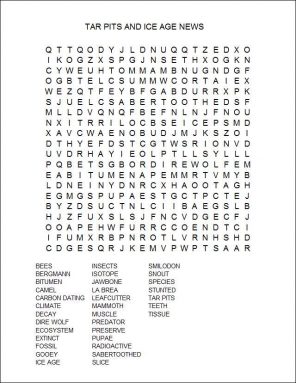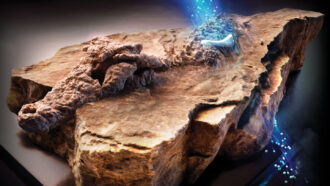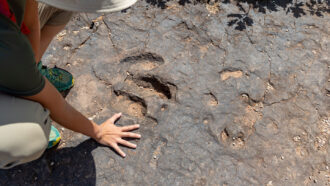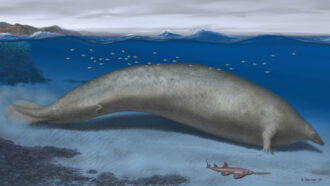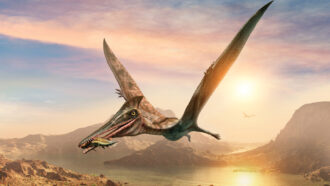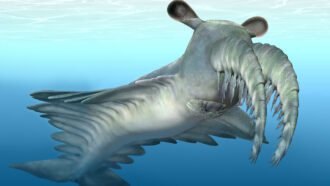Tar pit clues provide ice age news
Animal remains unearthed from tar pits reveal hints of hard times in the ancient past
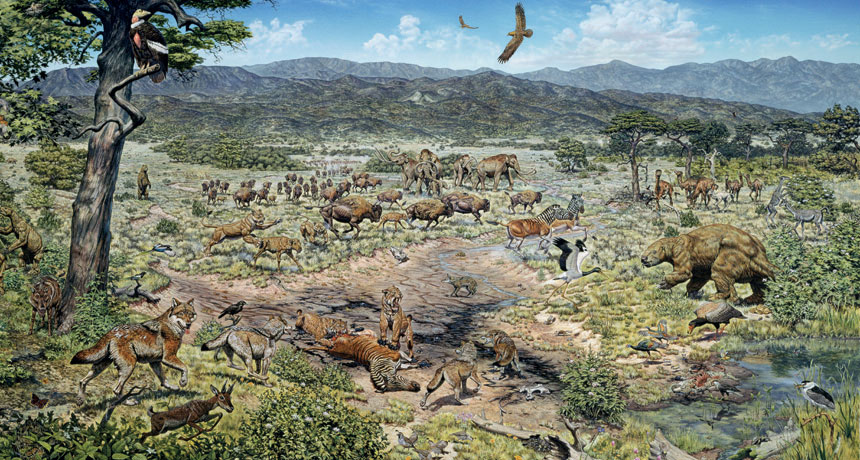
A mural by Mark Hallett in the Page Museum depicts hundreds of species whose fossils have been found in the La Brea Tar Pits.
Page Museum at the La Brea Tar Pits
By Sid Perkins
LOS ANGELES — Scientists often trek to remote areas in search of important fossils. Some spend weeks digging in the deserts of Asia, combing the dry hills of the American West or surveying mountainsides in Alaska. Others have spent decades working with picks and shovels much closer to home — including in an inner-city park here.
Over the past century, scientists have dug up millions of fossils from the La Brea Tar Pits. The fossils come from ice age creatures big and small. They were trapped over many thousands of years in soil made gooey by crude oil that was seeping up from deep underground. This has made the urban site one of the world’s most famous sources of ice age fossils.
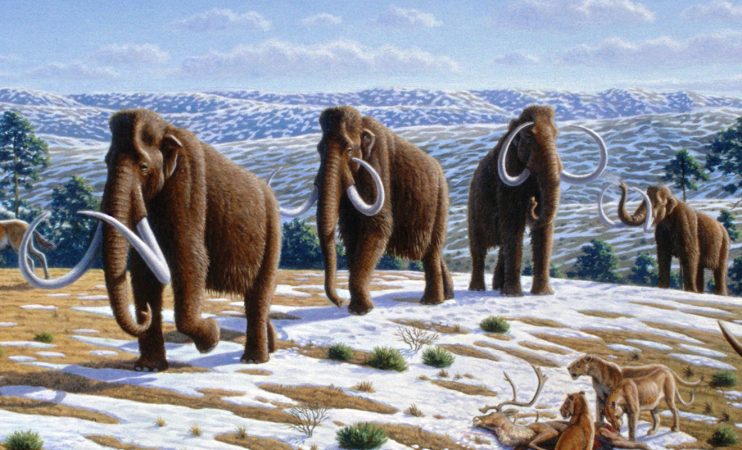
They represent more than 600 species of animals and plants that lived roughly 12,000 to 45,000 years ago. The fossils include many big animals, such as mammoths, camels and saber-toothed cats. Some preserve what’s left of ants, wasps, beetles and other tinier organisms. Many fossilized species have gone extinct. Others, including certain insects, no longer live in Los Angeles — but still can be found nearby.
During the last ice age, kilometers-thick ice sheets smothered large parts of Canada and the northern United States. No ice sheets covered what is now Southern California. There were nearby glaciers, however, on mountains east of Los Angeles.
Generally, the region’s climate was much cooler and wetter — about what it’s like today 480 kilometers (300 miles) to the north. Throughout the tens of thousands of years that the ice age lasted, average temperatures varied from year to year, and from one decade to the next. Only as the ice age ended did temperatures warm up for good.
Scientists can learn about the past climate by analyzing the clues contained in fossils of long-ago animals trapped in the tar pits.
By studying differences in the same species through time, researchers also can see how a changing climate affected the animals. Along the way, scientists have turned up some surprises. For instance, some animals didn’t always evolve in ways that researchers had expected.
Tiny clues
Despite its name, there is no tar at the La Brea Tar Pits. The viscous goo bubbling to the surface is actually a thick form of crude oil known as bitumen. The tar pits formed as this bitumen has oozed out from deep underground. In cool weather, the oil is firm. There is no getting stuck in it. But as the weather warms, the oil softens and turns gooey. Then, it can trap even large creatures.
In the late 1800s, ranchers who lived west of downtown Los Angeles discovered some old bones in their fields. For many years, the ranchers thought the bones were from cattle or other farm animals that happened to get stuck in the oil seeping up to the surface there. But in 1901, William Warren Orcutt realized the farmers had been wrong. This geologist, who worked for a California oil company, recognized that the bones came from ancient creatures.
A little more than a decade later, researchers began excavating the fantastic fossils at Rancho La Brea (Spanish for The Tar Ranch).
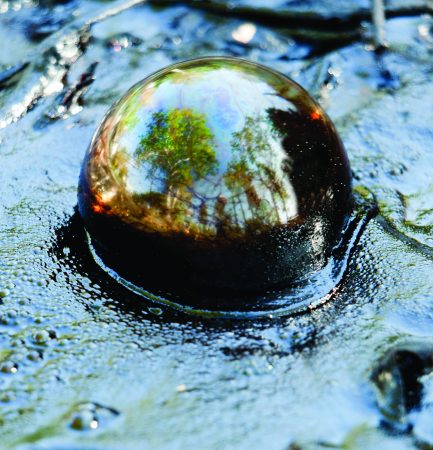
At first, paleontologists — the scientists who study fossils — were interested only in the bones of large, unusual creatures. These included mammoths (related to today’s elephants) and saber-toothed cats (relatives of lions and tigers). While those long-lost creatures were certainly impressive, the bitumen had trapped many smaller creatures too, notes Anna Holden. As a paleoentomologist (PAY-lee-oh-en-tow-MOL-oh-gist), she studies ancient insects. She does this for the Natural History Museum of Los Angeles County, not far from the tar pits.
Often, the tiny creatures that paleontologists had long ignored can provide big clues about the ecosystem in which they had lived. For example, last year Holden studied the burrows that insects had tunneled into the bones of bison, horses and other animals that eat grass. The bone-chewing insects had fed on the animals after they had died. Trapped in the tar pits, their remains had not yet sunk into the sticky muck.
The insects take at least four months to develop into adults, Holden notes. They are active only during the warmest months. This suggests that even in the middle of the last ice age, roughly 30,000 years ago, there were periods when the climate was warm enough for bitumen to trap animals — and for the insects that feed on them to be active. It also suggests that the summers must have lasted at least four months during these warm intervals.
Now, Holden’s at it again. This time, she’s looking at the fossils of two pupae from leafcutter bees. (“Pupae” is the plural of pupa, the life stage just before insects become adults.)
Those bee fossils had been dug up from the tar pits in 1970. They had been mined from about 2 meters (6.5 feet) below ground. This level held the remains of animals, including bugs, that had lived between 23,000 and 40,000 years ago.
Unlike honeybees, leafcutter bees don’t create hives. They live a solitary life. Their nests are tunneled into plant stems, rotting wood or loose soil. A female will lay an egg inside a tiny capsule made from bits of leaf trimmed from a tree or shrub. This behavior accounts for why the bees are called “leafcutters.”
The La Brea bee pupae had fed on pollen and nectar. The female bee had deposited the meal before she laid an egg and sealed its capsule.
Each capsules is only about 10.5 millimeters (0.41 inch) long and 4.9 millimeters (0.19 inch) in diameter. That is a tad smaller than the band of metal that holds in place a pencil eraser. Holden and her team used a powerful X-ray machine to make 3-D scans of each pupa. Then a computer combined hundreds of these scans, each depicting a thin slice of tissue only about one-third the thickness of the finest human hair. The result is a detailed, 3-D image that the computer can depict from any angle. The computer also can peer inside this digital mass to see internal structures or layers.
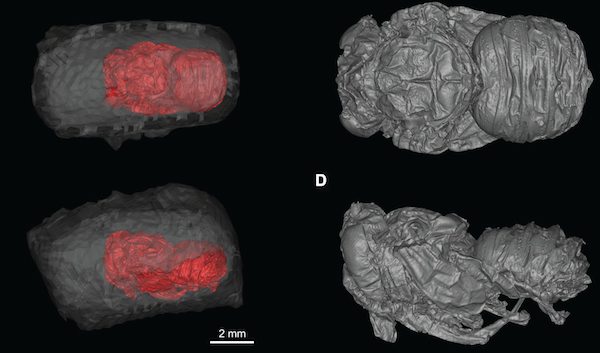
The pupae came from Megachile (Meh-guh-KY-lee) bees. Their fossil nest capsules are the first ever preserved from this genus, notes Holden. (A genus is a group of closely related species.) She and her co-workers described their findings in the April 2014 PLOS ONE.
It’s possible that rains washed the bee nests into a pool of bitumen, where the ooze later buried them, says Holden. However, that’s not likely. The fossils are so delicate, she explains, that flowing water likely would have ripped them apart. Instead, she thinks the bees must have dug their nests into soils at the tar pits. Later, seeping oil would have covered the nests, she suspects. Over time, soil and other material that washed or blew into the area would have buried the nests even deeper.
Megachile bees still live in California, just not around the tar pits. Holden suspects that’s largely because Los Angeles has become too warm and dry for them. Today, these bees live only in cooler, moister places. The mountains surrounding the Los Angeles basin host such conditions, starting at elevations of about 200 meters (660 feet) above sea level.
Because leafcutter bees tolerate only a very narrow environmental range, their fossils provide much more detailed data on local conditions than do the fossils of, say, wolves or camels. Those big guys withstood a much wider variety of conditions, including changes in temperature and precipitation.
In fact, Megachile fossils tell scientists that the area surrounding the tar pits at the time the pupae were buried would have been cooler and rainier than it is today. What’s more, streams or small rivers would have had to flow through the area back then, providing habitat for the plants that the bees used to create their leafy nests.
Evolution in action
The bitumen bubbling up at Rancho La Brea trapped creatures over a period of roughly 33,000 years. Even though that entire period lies within the last ice age, the climate varied a lot during that time.
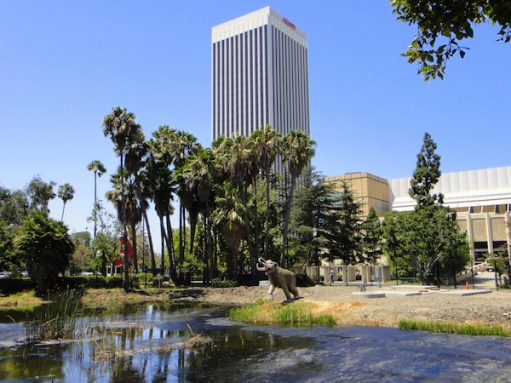
And that means those species had plenty of time to evolve, adapting to the region’s changing conditions. To probe whether they actually did, scientists need to look at a large sample of fossils from creatures that had died over a broad range of time, explains Julie Meachen. She’s a vertebrate paleontologist at Des Moines University in Iowa.
Smilodon fatalis, or the saber-toothed cat, is one of the best candidates, she notes. These ice-age beasts (once incorrectly known as saber-toothed tigers) were about the size of modern lions and tigers, but heftier. Their strong forelimbs helped them grab and bring down prey. The creature’s most distinctive features were its 25-centimeter (10-inch) fangs. In the past century, researchers have dug up fossils at the La Brea Tar Pits from more than 2,000 of these iconic creatures.
In a new study, Meachen and two other researchers looked at 123 jawbones from these fearsome predators. They came from several different tar pit sites. The experts measured 14 different aspects of the skulls. For instance, they measured the locations of certain teeth and the thickness of the jawbone. They also measured the angle at which the jawbone attached to the skull. That angle helped the scientists estimate the strength of each creature’s bite.
To calculate a fossil’s age, researchers typically measure how much carbon-14 it contains. Carbon-14 is a different form, or isotope, of the element. Isotopes vary somewhat in weight. Many isotopes are stable, while some, including carbon-14, undergo radioactive decay. That rate of decay is constant. For example, every 5,730 years, one half of all carbon-14 disappears from a sample of organic material — such as wood, bone or anything else that once was part of a living plant or animal. Measuring how much carbon-14 is “missing” allows scientists to compute its approximate age. This is called “carbon dating.”
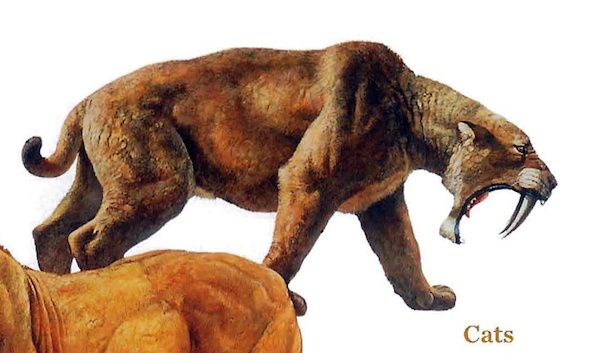
That dating suggests the big cats that left these fossils — along with any others unearthed from the same site — were trapped during several different intervals. These ranged from roughly 13,000 to 40,000 years ago.
Other studies had shown that jawbone length in meat-eating mammals is related to overall body size, says Meachen. Her team’s new jawbone analysis reveals that the saber-toothed cats were changing in size throughout the 27,000-year span. Moreover, she notes, “It appears that they were changing with the climate.”
For example, twice during that period — about 36,000 years ago and again about 26,000 years ago — the climate was relatively cool. At those times, the cats were relatively small, Meachen reports. But in between — some 28,000 years ago — the climate warmed. At this point, the cats became relatively big. The scientists describe their findings in the April Journal of Evolutionary Biology.
This trend doesn’t match what researchers had come to expect, Meachen notes. In biology, there’s a general rule about the body size of animals. It’s called Bergmann’s Rule. (It is named after the German scientist who studied living animals and came up with this rule in the 1840s.) This rule holds that creatures in colder regions are typically larger than closely related species living in warmer areas.
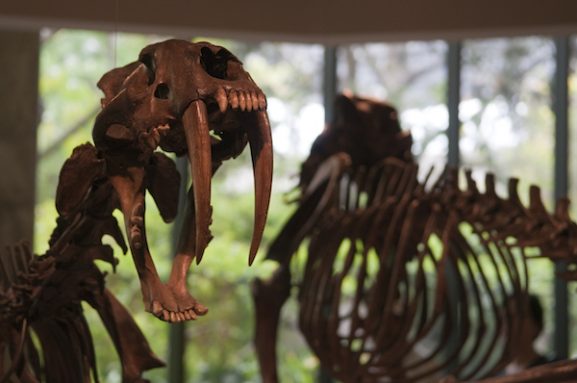
If this trend is applied to different points in time, says Meachen, then animals that live during cold periods should be larger than those that lived in warm times.
But fossils at Rancho La Brea don’t follow this rule. And it’s not clear why, Meachen adds. It’s possible that the size of saber-toothed cats changed in response to the availability of food. When the climate was cool and food was plentiful, being big would not necessarily have been an advantage. But as the climate warmed and became food scarce, cats might have needed a size advantage to compete against other predators.
From cats to the ‘dogs’
Another recent study of tar pit fossils came up with similar results. This analysis was very similar to Meachen’s analysis of saber-toothed cats. But here, scientists focused on dire wolves (Canis dirus). These extinct creatures were about the size of gray wolves today. But like the saber-toothed cats, these wolves were heftier than their modern kin.
Researchers have unearthed fossils of more than 4,000 dire wolves at Rancho La Brea.
In the new study, Robin O’Keefe and his co-workers analyzed 73 dire wolf skulls. O’Keefe is a paleontologist at Marshall University in Huntington, W. Va. On each skull, the team mapped the location of 27 biological “landmarks.” These included teeth, eye sockets and where the jaw muscles had attached to the bone. As with the cats, the overall shape of the dire wolves’ skulls changed through time, he reports.
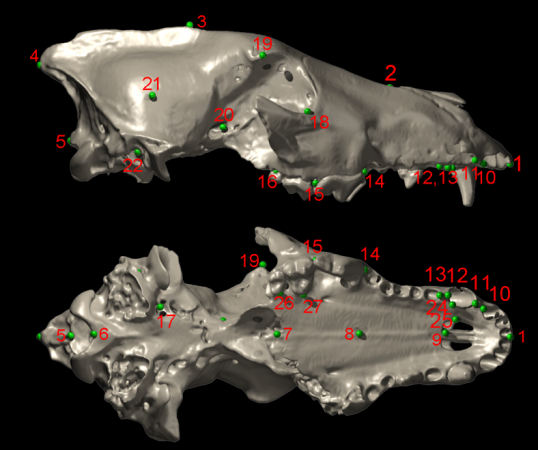
Dire wolves were smaller at the peak of the last ice age, when the region’s climate was at its coldest. Again, that doesn’t match the trend expected from Bergmann’s Rule, O’Keefe notes. His team reported its findings in the January-April Palaeontologia Electronica.
“When the climate was warm, it really stressed the ecosystem,” O’Keefe explains. As a result, the wolves’ growth often was stunted. They typically had shorter snouts and many more broken teeth than did wolves living during cooler times. Hard times may have forced them to crack open large bones as the wolves hunted for scarce nutrients, O’Keefe suspects. And that would have boosted the risk of fracturing teeth.
Like Meachen and her work on saber-toothed cats, O’Keefe thinks that how much food was around had a big effect on the size of a dire wolf’s body.
To verify that, researchers could dig deeper into the fossil record, says O’Keefe. For example, he explains, scientists could measure the ratio of nitrogen-14 to nitrogen-15 in the fossils. If the proportion of nitrogen-15 is unusually high, it could be a sign that the predators were at the top of a food chain that included many levels of creatures. Over time, variations in that ratio of nitrogen isotopes can point to changes, and not just in the eating habits of a species.
“These things could tell us how the ecosystems were changing,” says O’Keefe. “We really should be bending over backward to see what that fossil record can tell us.”
